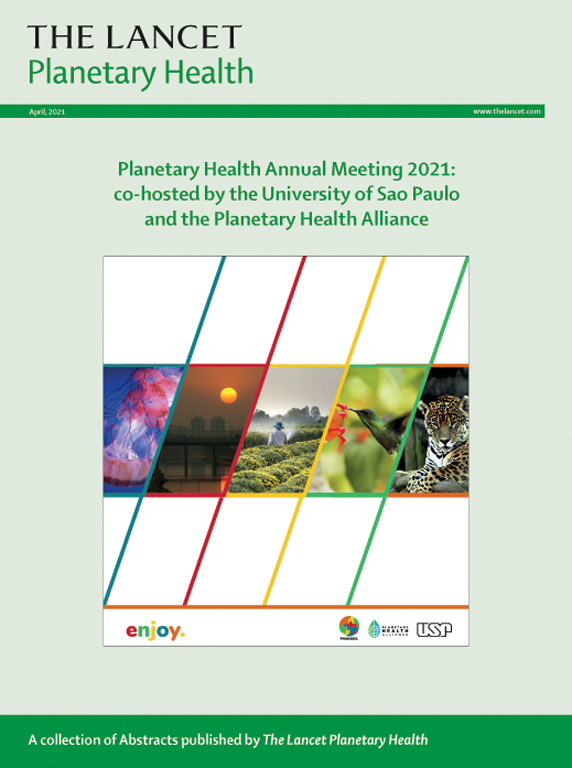Impact of a 10-year shift in ambient air quality on mortality in Canada: a causal analysis of multiple pollutants
IF 24.1
1区 医学
Q1 ENVIRONMENTAL SCIENCES
引用次数: 0
Abstract
Background
The impact of past air quality improvements on health and equity at low pollution levels near the revised WHO air quality guidelines remains largely unknown. Less is known about the influence of simultaneous reductions in multiple major pollutants. Leveraging real-world improvements in air quality across Canada, we sought to directly evaluate their health benefits by quantifying the impact of a joint shift in three criteria pollutants on mortality in a national cohort.
Methods
In this population-based cohort study, we assembled a cohort of 2·7 million adults living in Canada in 2007 who were followed up through 2016. Annual mean concentrations of fine particulate matter (PM2·5), nitrogen dioxide (NO2), and ozone (O3) were assigned to participants’ residential locations. For each pollutant individually and combined, we conducted a causal analysis of the impact of the decadal shift in annual exposure from the pre-baseline level (2004–06) on the risk of non-accidental mortality using the parametric g-formula, a structural causal model. To check the robustness of our results, we conducted multiple sensitivity analyses, including exploring alternative exposure scenarios. We also evaluated differential benefits across regions and socio-demographic subgroups.
Findings
Between 2007 and 2016, annual mean exposures to PM2·5 and NO2 decreased (from 7·1 μg/m3 [SD 2·3] to 5·5 μg/m3 [1·9] for PM2·5 and from 11·1 ppb [SD 6·6] to 8·0 ppb [4·9] for NO2), whereas O3 declined initially and then rebounded (from 38·6 [SD 8·3] ppb to 36·0 [6·0] ppb and then 38·1 [5·4] ppb). Compared to pre-baseline (2004–06) levels, the joint change in the pollution exposures beginning in 2007 resulted in, per million population, 70 (95% CI 29–111) fewer deaths by 2009, 416 (283–549) fewer deaths by 2012, and 609 (276–941) fewer deaths by 2016, corresponding to a –0·7% change in mortality risk over the decade. Stratified analyses showed greater beneficial impacts in men, adults aged 50 years and older, low income-earners, and residents in regions undergoing substantial air quality improvements. Had all regions experienced pollution reductions similar to the most improved region, approximately three times as many deaths would have been averted (2191 fewer deaths per million). Conversely, if the observed air quality improvements had been delayed in all regions by 3 years, there would have been 429 more deaths per million by 2016.
Interpretation
In Canada, substantial health gains were associated with air quality improvements at levels near the revised WHO guidelines between 2007 and 2016, with notable heterogeneity observed across socio-demographic subgroups and regions. These findings indicate that modest declines in air pollution can considerably improve health and equity, even in low-exposure environments.
Funding
Health Canada.
加拿大环境空气质量10年变化对死亡率的影响:多种污染物的因果分析
在接近经修订的世卫组织空气质量准则的低污染水平,过去空气质量改善对健康和公平的影响在很大程度上仍然未知。对于同时减少多种主要污染物的影响,人们所知甚少。利用加拿大各地实际空气质量的改善,我们试图通过量化三种标准污染物对全国队列死亡率的共同变化的影响来直接评估其健康效益。方法在这项基于人群的队列研究中,我们收集了2007年居住在加拿大的270万成年人的队列,随访至2016年。细颗粒物(PM2·5)、二氧化氮(NO2)和臭氧(O3)的年平均浓度被分配到参与者的居住地。对于每一种污染物单独和组合,我们使用参数g公式(一种结构因果模型)对年暴露量从基线前水平(2004 - 2006年)的年代际变化对非意外死亡风险的影响进行了因果分析。为了检验结果的稳健性,我们进行了多种敏感性分析,包括探索不同的暴露情景。我们还评估了不同地区和社会人口亚组的差异收益。研究结果:2007 - 2016年,pm2.5和NO2的年平均暴露量下降(pm2.5从7.1 μg/m3 [SD 2.3]降至5.5 μg/m3[1·9],NO2从11.1 ppb [SD 6.6]降至8.0 ppb[4·9]),而O3则先下降后反弹(从38.6 [SD 8.3] ppb降至36.0 [6.0]ppb,再降至38.1[5·4]ppb)。与基线前(2004-06)水平相比,2007年开始的污染暴露的联合变化导致到2009年每百万人口死亡人数减少70人(95% CI 29-111),到2012年死亡人数减少416人(283-549),到2016年死亡人数减少609人(276-941),相当于十年来死亡风险变化了- 0.7%。分层分析显示,空气质量显著改善地区的男性、50岁及以上的成年人、低收入者和居民受益更大。如果所有区域的污染减少程度都与改善程度最高的区域相似,那么所避免的死亡人数将增加约三倍(每百万人的死亡人数减少2191人)。相反,如果观察到的空气质量改善在所有区域推迟3年,到2016年,每百万人的死亡人数将增加429人。在加拿大,2007年至2016年期间,空气质量改善的水平接近世卫组织修订指南的水平,这与健康状况的实质性改善有关,在社会人口亚群体和地区之间观察到显著的异质性。这些研究结果表明,即使在低暴露环境中,空气污染的适度减少也可以大大改善健康和公平。FundingHealth加拿大。
本文章由计算机程序翻译,如有差异,请以英文原文为准。
求助全文
约1分钟内获得全文
求助全文
来源期刊

Lancet Planetary Health
Multiple-
CiteScore
28.40
自引率
2.30%
发文量
272
审稿时长
8 weeks
期刊介绍:
The Lancet Planetary Health is a gold Open Access journal dedicated to investigating and addressing the multifaceted determinants of healthy human civilizations and their impact on natural systems. Positioned as a key player in sustainable development, the journal covers a broad, interdisciplinary scope, encompassing areas such as poverty, nutrition, gender equity, water and sanitation, energy, economic growth, industrialization, inequality, urbanization, human consumption and production, climate change, ocean health, land use, peace, and justice.
With a commitment to publishing high-quality research, comment, and correspondence, it aims to be the leading journal for sustainable development in the face of unprecedented dangers and threats.
 求助内容:
求助内容: 应助结果提醒方式:
应助结果提醒方式:


